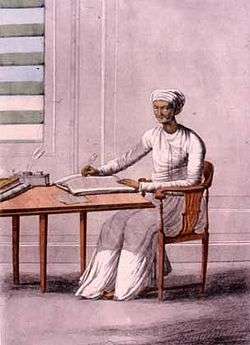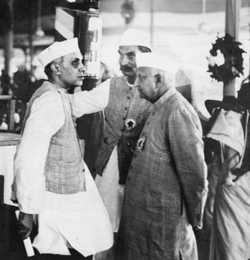Kayastha

Kayastha (also referred to as Kayasth or Kayeth) is a caste or community of Hindus originating in India. Kayasthas are considered to be members of the literate scribe caste, and have traditionally acted as keepers of records and public accounts, writers, and administrators of the state.
Kayasthas have historically occupied the highest government offices, serving as ministers and advisors during early medieval Indian kingdoms and the Mughal Empire, and holding important administrative positions during the British Raj.
In modern times, Kayasthas have attained success in politics, as well as in the arts and various professional fields.[1]
Origins
According to the Hindu scriptures known as the Puranas, Kayasthas are descended from Chitragupta, "who was born from the body of Brahma", and is the deity responsible for recording the deeds of humanity, upholding the rule of law, and judging whether human beings go to heaven or hell upon death.[2]
Brahmanical religious texts refer to them as a caste of scribes, recruited in the beginning from the Brahmin, Kshatriya and Vaishya castes, but eventually forming distinct subcastes in northern and western India. Kayasthas have therefore also been mentioned as a "mixed caste", combining Brahman-Sudra (lower caste) and sometimes Kshatriya as well.[1]
In eastern India, Bengali Kayasthas are believed to have evolved from a class of officials into a caste between the 5th/6th centuries and 11th/12th centuries, its component elements being putative Kshatriyas and mostly Brahmins, and likely obtained the aspect of a caste under the Sena dynasty.[3] According to Tej Ram Sharma, an Indian historian, the Kayasthas of Bengal had not yet developed into a distinct caste during the reign of the Gupta Empire, although the office of the Kayasthas (scribes) had been instituted before the beginning of the period, as evidenced from the contemporary Smritis. Sharma further states:
"Noticing brahmanic names with a large number of modern Bengali Kayastha cognomens in several early epigraphs discovered in Bengal, some scholars have suggested that there is a considerable brahmana element in the present day Kayastha community of Bengal. Originally the professions of Kayastha (scribe) and Vaidya (physician) were not restricted and could be followed by people of different varnas including the brahmanas. So there is every probability that a number of brahmana families were mixed up with members of other varnas in forming the present Kayastha and Vaidya communities of Bengal."[4]
Varna status

The exact varna status of Kayasthas has been a subject of debate. According to multiple accounts, they are a literate and educated class of Kshatriyas, and have been referred to as a twice-born caste.[5][6] Other sources rank Kayasthas higher than Kshatriyas (between Brahmins and Khatris).
In Bengal, Kayasthas, alongside Brahmins, are regarded as the "highest Hindu castes"[7] that comprise the "upper layer of Hindu society."[8] After the Muslim conquest of India, Kayasthas absorbed remnants of Bengal's old Hindu ruling dynasties - including the Sena, Pala, Chandra, and Varman - and, in this way, became the region's surrogate Kshatriya or "warrior" class.[9]
In Maharashtra, the Chandraseniya Kayastha Prabhu claim Kshatriya status through descent from a Kshatriya king of the Haihaya clan.
In northern India and Pakistan, Muslim Kayasthas are descended from members of the Hindu Kayastha community that converted to Islam during the 15th-16th centuries.
During the British Raj, British courts classified Kayasthas as Shudras, based largely upon the theories of Herbert Hope Risley. However, the Kayasthas of Bengal, Bombay and the United Provinces repeatedly challenged this classification, producing a flood of books, pamphlets, family histories and journals to support their position of holding Kshatriya status.[10]
History
Classical India

Brahmanical religious texts refer to Kayasthas as a caste responsible for writing secular documents and maintaining records from the 7th century AD onward.[1]
According to the historical chronicle known as the Rajatarangini ("River of Kings"), written by Kalhana in the 12th century AD, Kayasthas served as prime ministers and treasury officials under several Kashmiri kings.[11]
Prior to the 13th century AD, during the rule of Hindu kings, Kayasthas dominated public service and had a near-monopoly on appointments to government positions.[12] They may also have been described as Karanas, since the two groups performed similar functions.[13]
According to Abu al-Fazl, Emperor Akbar's prime minister, Kayasthas were rulers of the Pala Empire, one of the major early medieval Indian kingdoms that originated in Bengal.[3]
In Bengal, during the reign of the Gupta Empire beginning in the 4th century AD, when systematic and large-scale colonization by Aryan Kayasthas and Brahmins first took place, Kayasthas were brought over by the Guptas to help manage the affairs of state.[14]
Medieval India
After the Muslim conquest of India, Kayasthas mastered Persian,[1] which became the official language of the Mughal courts.[15] Some converted to Islam and formed the Muslim Kayasth community in northern India.
One of the most notable Kayasthas of the Mughal period was Raja Todar Mal, Emperor Akbar's finance minister and one of the court's nine Navaratnas, who is credited with establishing the Mughal revenue system.[16] He also translated the Bhagavata Purana from Sanskrit into Persian.[17]
In Bengal, Kayasthas had been the dominant landholding caste prior to the Muslim conquest, and continued this role under Muslim rule. Indeed, Muslim rulers had from a very early time confirmed the Kayasthas in their ancient role as landholders and political intermediaries.[9]
Bengali Kayasthas served as governors, prime ministers and treasury officials under Mughal rule.[18]
As a result of their exalted status amongst Muslim sultans, many Bengali Kayasthas became zamindars and jagirdars. According to Abu al-Fazl, most of the Hindu zamindars in Bengal were Kayasthas.[19]
Maharaja Pratapaditya, the King of Jessore who declared independence from Mughal rule in the early 17th century, was a Kayastha.
British India
During the British Raj, Kayasthas continued to proliferate in public administration, qualifying for the highest executive and judicial offices open to Indians.[18]
Bengali Kayasthas took on the role occupied by merchant castes in other parts of India and profited from business contacts with the British. In 1911, for example, Kayasthas and Brahmins owned 40% of all the Indian-owned mills, mines and factories in Bengal.[20]
Some of the significant figures of the Indian independence movement were Kayasthas, including the spiritual leaders Swami Vivekananda and Sri Aurobindo, and the revolutionary leader Subhas Chandra Bose.[21][22]
Modern India
The Kayastha are found mostly in central, eastern and northern India, and particularly in Bengal.[23] Today, there are an estimated 800,000 Kayasthas in India. Kayasthas that have risen to prominence since independence include the country's first president, Rajendra Prasad, and its second prime minister, Lal Bahadur Shastri.[1]
Kayasthas are considered a Forward Caste, as they do not qualify for any of the reservation benefits allotted to Scheduled Castes, Scheduled Tribes and Other Backward Classes that are administered by the Government of India.[24]
Notables
Some noteworthy people of the Kayastha caste of India
- Subhas Chandra Bose, popularly known as Netaji ("Respected Leader")[25]
- Swami Vivekananda, born Narendra Nath Datta[26]
- Sonu Nigam[27]
- Jayaprakash Narayan
- Rajendra Prasad[28]
- Ravi Shankar Prasad[29]
- Lal Bahadur Shastri[30]
- Shatrughan Sinha[31]
- Premchand, born Dhanpat Rai Srivastav[32]
- Mahadevi Varma[33]
See also
References
- 1 2 3 4 5 Arnold P. Kaminsky, Roger D. Long (2011). India Today: An Encyclopedia of Life in the Republic. ABC-CLIO. pp. 403–404. ISBN 978-0-313-37462-3. Retrieved 4 March 2012.
- ↑ R. B. Mandal (1981). Frontiers in Migration Analysis. Concept Publishing Company. p. 175. ISBN 978-03-91-02471-7.
- 1 2 Andre Wink (1991). Al-Hind, the Making of the Indo-Islamic World, Volume 1. Brill Academic Publishers. p. 269. ISBN 978-90-04-09509-0. Retrieved 3 September 2011.
- ↑ Sharma, Tej Ram (1978). Personal and Geographical Names in the Gupta Empire. New Delhi: Concept Publishing Company. p. 115.
- ↑ Mendis, Dushyantha (2007). Electoral Processes and Governance in South Asia. SAGE Publications India. p. 427. ISBN 978-8-178-29970-9.
- ↑ Jayaswal, Prem Kumar (1990). Librarianship and Bureaucratic Organisation: A Study in the Sociology of Library Profession in India, Volume 1. Concept Publishing Company. p. 68. ISBN 978-8-170-22321-4.
- ↑ Inden, Ronald B. (1976). Marriage and Rank in Bengali Culture: A History of Caste and Clan in Middle Period Bengal. University of California Press. p. 1. ISBN 978-0-520-02569-1. Retrieved 18 April 2011.
- ↑ Bhattacharya, Jogendra Nath (1896). Hindu Castes and Sects. Calcutta: Thacker, Spink & Co. p. 175. Retrieved 2011-10-31.
- 1 2 Richard Maxwell Eaton (1996). The Rise of Islam and the Bengal Frontier, 1204-1760. University of California Press. pp. 102–103. Retrieved 2014-12-30.
- ↑ Rowe, William L. (2007) [1968]. "Mobility in the nineteenth-century caste system". In Singer, Milton; Cohn, Bernard S. Structure and Change in India Society (Reprinted ed.). Transaction Publishers. p. 202. ISBN 978-0-202-36138-3. Retrieved 2011-12-17.
- ↑ Kalhana (1989). Stein, Sir Marc Aurel, ed. Kalhana's Rajatarangini: A Chronicle of the Kings of Kashmir. Motilal Banarsidass Publishers. pp. 8, 39, 45. ISBN 978-81-20-80370-1. Retrieved 17 April 2013.
- ↑ Jogendra Nath Bhattacharya (1896). Hindu Castes and Sects. Thacker, Spink & Co./Nabu Press. p. 176. ISBN 978-1-143-93343-1. Retrieved 14 August 2011.
- ↑ Mitra, Sisirkumar (1977). The Early Rulers of Khajurāho. Motilal Banarsidass Publishers. p. 174. ISBN 978-8-120-81997-9. Retrieved 20 December 2013.
- ↑ U. A. B. Razia Akter Banu (1992). Islam in Bangladesh. Brill Academic Publishers. pp. 5–6. ISBN 978-90-04-09497-0. Retrieved 15 August 2011.
- ↑ Lisa Ballbanlilar (2012). Imperial Identity in Mughal Empire: Memory and Dynastic Politics in Early Modern Central Asia. I.B. Taurus & Co., Ltd. p. 59. ISBN 978-1-84885-726-1. Retrieved 7 June 2012.
- ↑ Hugh Tinker (1990). South Asia: A Short History. University of Hawaii Press. p. 56. ISBN 978-0-8248-1287-4. Retrieved 15 August 2011.
- ↑ Rahman, M.M. (2006). Encyclopaedia of Historiography. Anmol Publications. p. 168. ISBN 978-81-261-2305-6. Retrieved 26 February 2010.
- 1 2 Jogendra Nath Bhattacharya (1896). Hindu Castes and Sects. Thacker, Spink & Co./Nabu Press. pp. 176–177. ISBN 978-1-143-93343-1. Retrieved 14 August 2011.
- ↑ U. A. B. Razia Akter Banu (1992). Islam in Bangladesh. Brill Academic Publishers. pp. 24–25. ISBN 978-90-04-09497-0. Retrieved 15 August 2011.
- ↑ Raymond Lee Owens, Ashis Nandy (1978). The New Vaisyas. Carolina Academic Press. p. 81. ISBN 978-0-89089-057-8. Retrieved 14 August 2011.
- ↑ Samaren Roy (1999). The Bengalees: Glimpses of History and Culture. Allied Publishers. p. 81. ISBN 978-8170239819. Retrieved 26 June 2012.
- ↑ Sugata Bose (2011). His Majesty's Opponent: Subhas Chandra Bose and India's Struggle Against Empire. Harvard University Press. p. 18. ISBN 978-0674047549. Retrieved 22 June 2012.
- ↑ Surinder Mohan Bhardwaj (1983). Hindu Places of Pilgrimage in India: A Study in Cultural Geography. University of California Press. p. 231. ISBN 978-0-520-04951-2. Retrieved 19 April 2011.
- ↑ Srinivasan, K.; Kumar, Sanjay (16–23 October 1999). "Economic and Caste Criteria in Definition of Backwardness". Economic and Political Weekly 34 (42/43): 3052. Retrieved 7 June 2012.
- ↑ A. Pelinka, R. Schell (2003). Democracy Indian Style: Subhas Chandra Bose and the Creation of India's Political Culture. Transaction Publishers. p. 32. ISBN 978-07-6580-186-9.
- ↑ Banhatti, G.S. (1995). Life and Philosophy of Swami Vivekananda. Atlantic Publishers & Distributors. p. 1. ISBN 978-81-7156-291-6. Retrieved 5 July 2012.
- ↑ India Today: An Encyclopedia of Life in the Republic:Volume 1
- ↑ http://timesofindia.indiatimes.com/home/lok-sabha-elections-2014/news/Bold-Banias-conquer-nayi-duniya/articleshow/35227723.cms
- ↑ Vyas, Hari Shankar (7 April 2013). "Brahmins in Congress on tenterhooks". The Pioneer. Retrieved 9 June 2014.
- ↑ Burger, Angela Sutherland (1969). Opposition in a Dominant Party System: A study of the Jan Sangh, the Praja Socialist Party and the Socialist Party in Uttar Pradesh, India. University of California Press. p. 28.
- ↑
- ↑
- ↑ Schomer, Karine (1998). Mahadevi Varma and the Chhayavad Age of Modern Hindi Poetry. New Delhi: Oxford University Press. ISBN 0-19-564450-6.
Further reading
- Asok Mitra (Indian Civil Service, Superintendent of Census Operations) (1953). The tribes and castes of West Bengal. Superintendent, Govt. Print. West Bengal Govt. Press. Retrieved 28 April 2011.
- Colonial Perceptions of Indian Society and the Emergence of Caste(s) Associations Lucy Carroll, The Journal of Asian Studies, Vol. 37, No. 2 (Feb., 1978), pp. 233–250.